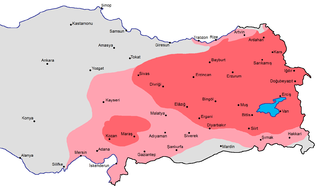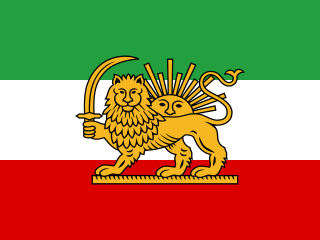
The Qajar Empire, also referred to as Qajar Iran, officially the Sublime State of Persia, was the state ruled by the Qajar dynasty, an Iranian royal dynasty of Turkic origin, specifically from the Qajar tribe, from 1789 to 1925. The Qajar family took full control of Iran in 1794, deposing Lotf 'Ali Khan, the last Shah of the Zand dynasty, and re-asserted Iranian sovereignty over large parts of the Caucasus. In 1796, Mohammad Khan Qajar seized Mashhad with ease, putting an end to the Afsharid dynasty, and Mohammad Khan was formally crowned as Shah after his punitive campaign against Iran's Georgian subjects. In the Caucasus, the Qajar dynasty permanently lost many of Iran's integral areas to the Russians over the course of the 19th century, comprising modern-day Georgia, Dagestan, Azerbaijan and Armenia.
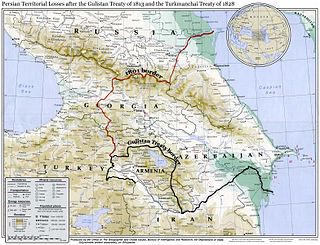
The Treaty of Gulistan was a peace treaty concluded between Imperial Russia and Persia on 24 October 1813 in the village of Gulistan as a result of the first full-scale Russo-Persian War, lasting from 1804 to 1813. The peace negotiations were precipitated by Lankaran's fall to Gen. Pyotr Kotlyarevsky on 1 January 1813.

The Treaty of Turkmenchay was an agreement between Persia (Iran) and the Russian Empire, which concluded the Russo-Persian War (1826–28). It was signed on 10 February 1828 in Torkamanchay, Iran. By the treaty, Persia ceded to Russia control of several areas in the South Caucasus: the Erivan Khanate, the Nakhchivan Khanate, and the remainder of the Talysh Khanate. The boundary between Russian and Persia was set at the Aras River. These territories comprise modern-day Armenia, the southern parts of the modern-day Republic of Azerbaijan, Nakhchivan, as well as Iğdır Province.

The Afsharid dynasty were members of an Iranian dynasty that originated from the Turkic Afshar tribe in Iran's north-eastern province of Khorasan, ruling Persia in the mid-eighteenth century. The dynasty was founded in 1736 by the brilliant military commander Nader Shah, who deposed the last member of the Safavid dynasty and proclaimed himself Shah of Iran.

Mohammad Ali Mirza Dowlatshah was a famous Persian Prince of the Qajar Dynasty. He is also the progenitor of the Dowlatshahi Family of Persia. He was born at Nava, in Mazandaran, a Caspian province in the north of Iran. He was the first son of Fath-Ali Shah, the second Qajar king of Persia, and Ziba Chehr Khanoum, a Georgian slave girl of the Tsikarashvili family. He was also the elder brother of Abbas Mirza. Dowlatshah was the governor of Fars at age 9, Qazvin and Gilan at age 11, Khuzestan and Lorestan at age 16, and Kermanshah at age 19.

The Middle Eastern theatre of World War I saw action between 29 October 1914 and 30 October 1918. The combatants were, on one side, the Ottoman Empire, with some assistance from the other Central Powers; and on the other side, the British, the Russians and the French from among the Allied Powers. There were five main campaigns: the Sinai and Palestine Campaign, the Mesopotamian Campaign, the Caucasus Campaign, the Persian Campaign, and the Gallipoli Campaign. There were also several minor campaigns: the Senussi Campaign, Arab Campaign, and South Arabia Campaign.
With thousands of years of recorded history, and due to an unchanging geographic condition, Iran has had a long, varied, and checkered military culture and history, ranging from triumphant and unchallenged ancient military supremacy affording effective superpower status in its day, to a series of near catastrophic defeats at the hand of previously subdued and conquered peripheral nations.
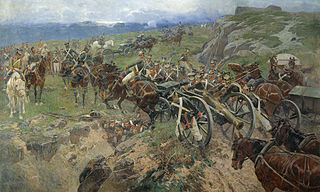
The 1804–1813 Russo-Persian War was one of the many wars between the Persian Empire and Imperial Russia, and began like many of their wars as a territorial dispute. The new Persian king, Fath Ali Shah Qajar, wanted to consolidate the northernmost reaches of his kingdom—modern-day Georgia—which had been annexed by Tsar Paul I several years after the Russo-Persian War of 1796. Like his Persian counterpart, the Tsar Alexander I was also new to the throne and equally determined to control the disputed territories.

The Russo-Persian War of 1826–28 was the last major military conflict between the Russian Empire and Iran.
The Treaty of Zuhab, also called Treaty of Qasr-e Shirin, was an accord signed between the Safavid Empire and the Ottoman Empire on May 17, 1639. The accord ended the Ottoman-Safavid War of 1623-1639 and was the last conflict in almost 150 years of intermittent wars between the two states over territorial disputes. It can roughly be seen as a confirmation of the previous Peace of Amasya from 1555.

The Persian Campaign or Invasion of Persia also known as Invasion of Iran was a series of engagements in Iranian Azerbaijan and western Iran (Persia) involving the forces of the Ottoman Empire against those of the British Empire and Russian Empire, and also involving local population elements, beginning in December 1914 and ending with the Armistice of Mudros on October 30, 1918 as part of Middle Eastern theatre of World War I.
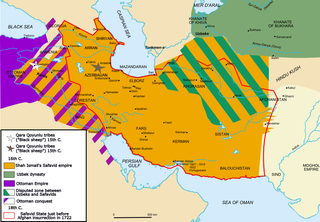
The Ottoman–Safavid War of 1623–1639 was the last of a series of conflicts fought between the Ottoman Empire and Safavid Persia, then the two major powers of Western Asia, over control of Mesopotamia. After initial Persian success in recapturing Baghdad and most of modern Iraq, having lost it for 90 years, the war became a stalemate as the Persians were unable to press further into the Ottoman Empire, and the Ottomans themselves were distracted by wars in Europe and weakened by internal turmoil. Eventually, the Ottomans were able to recover Baghdad, taking heavy losses in the final siege, and the signing of the Treaty of Zuhab ended the war in an Ottoman victory. Roughly speaking, the treaty restored the borders of 1555, with the Safavids keeping Dagestan, eastern Georgia, Eastern Armenia, and the present-day Azerbaijan Republic, while western Georgia and Western Armenia decisively came under Ottoman rule. The eastern part of Samtskhe (Meskheti) was irrevocably lost to the Ottomans as well as Mesopotamia. Despite parts of Mesopotamia were briefly retaken by the Iranians later on in history, notably during the reigns of Nader Shah (1736-1747) and Karim Khan Zand (1751-1779), it remained thenceforth in Ottoman hands until the aftermath of World War I.
The Ottoman–Safavid War of 1603–18 consisted of two wars between Safavid Persia under Abbas I of Persia and the Ottoman Empire under Sultan Ahmed I. The first war began in 1603 and ended with a Safavid victory in 1612, when Persia regained and reestablished its suzerainty over the Caucasus and Western Iran, which had been lost at the Treaty of Constantinople in 1590. The second war began in 1615 and ended in 1618 with minor territorial adjustments.
The Ottoman–Safavid War (1578–1590) was one of the many wars between the neighboring arch rivals of Safavid Persia and the Ottoman Empire.

A Franco-Persian alliance or Franco-Iranian alliance was formed for a short period between the French Empire of Napoleon I and Fath Ali Shah against Russia and Great Britain between 1807 and 1809. The alliance was part of a plan to gather extra aid against Russia and by Persia's help, having another front on Russia's southern borders, namely the Caucasus region. The alliance unravelled when France finally allied with Russia and turned its focus to European campaigns.
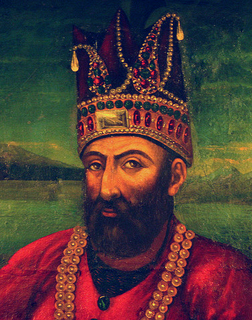
Nader Shah Afshar was one of the most powerful Iranian rulers in the history of the nation, ruling as Shah of Iran (Persia) from 1736 to 1747 when he was assassinated during a rebellion. Because of his military genius as evidenced in his numerous campaigns throughout Middle East, Caucasus, Central and South Asia, such as the battles of Herat, Mihmandust, Murche-Khort, Kirkuk, Yeghevard, Khyber Pass, Karnal and Kars, some historians have described him as the Napoleon of Persia, Sword of Persia, or the Second Alexander. Nader Shah was an Iranian who belonged to the Turkmen Afshar tribe of Khorasan in northeastern Iran, which had supplied military power to the Safavid dynasty since the time of Shah Ismail I.
The Treaties of Erzurum were two treaties of 1823 and 1847 that settled boundary disputes between the Ottoman Empire and Persia.

The Battle of Sultanabad occurred on February 13, 1812, between the Russian Empire and Persian Empire. In the resulting battle, the Russians were routed.
Musa Khamis was an Iranian general in the war between Qajar Empire and the Ottoman Empire in 1821.





